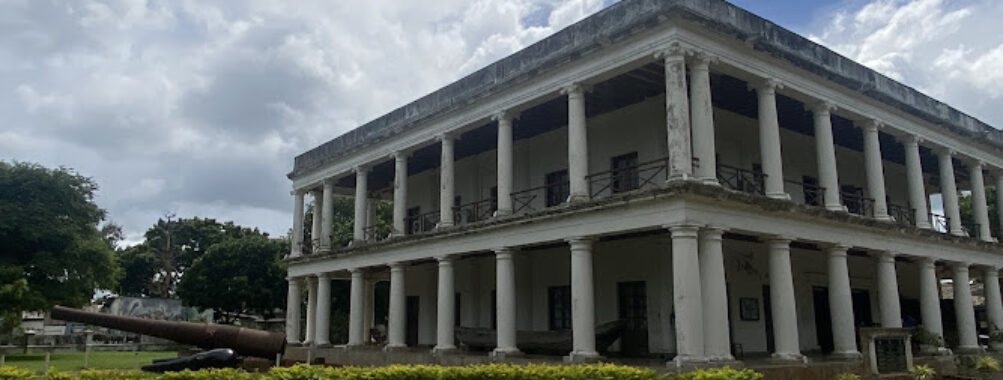
Maritime And Naval History Museum
“`html
Table of Contents
Description
The Maritime and Naval History Museum sits inside a 17th-century Dutch commissioner’s residence, a building that itself feels like part of the story it’s trying to tell. Walking through its thick wooden doors, you immediately sense the weight of centuries of sea trade, colonial encounters, and naval battles. It’s not the kind of museum that overwhelms you with endless rows of objects; instead, it feels more personal, almost like you’ve been invited into someone’s home—albeit a home filled with cannons, navigational charts, and weathered uniforms.
Some visitors describe it as modest, others find it unexpectedly rich. That’s the thing—it depends on what you’re looking for. If you’re expecting a giant, glossy museum with interactive screens at every corner, you might be underwhelmed. But if you love the smell of old wood, the creak of floors that have seen centuries of footsteps, and artifacts that carry stories of sailors who braved storms and wars, this place delivers in spades. I remember stepping into a room with model ships so detailed I had to lean in close just to admire the rigging. It made me think of my grandfather’s stories about building model boats when he was young, and suddenly the whole experience felt personal.
There’s a quiet charm here that rewards those who slow down. You’ll find naval maps that look like they’ve been pulled straight from a captain’s desk, weapons that remind you of how brutal sea battles could be, and even everyday objects sailors carried with them. And while the collection is not massive, it’s curated with a sense of care that makes you appreciate each piece. It’s the kind of museum where you can imagine the lives behind the artifacts, and that’s what makes it stand out.
Key Features
- Located in a 17th-century Dutch commissioner’s residence, blending architecture with maritime history
- Exhibits include naval artifacts, model ships, navigational maps, and historical weaponry
- Wheelchair accessible entrance, parking, and restrooms for inclusive access
- Family-friendly atmosphere with exhibits that spark curiosity in kids
- Restrooms available on-site, though no in-house restaurant (plan meals accordingly)
- Curated displays that emphasize stories and context rather than sheer volume
- A quieter, less crowded museum experience compared to larger attractions
Best Time to Visit
Visiting in the morning is often the best choice. The light filters beautifully through the old windows, giving the rooms a slightly golden glow that makes the artifacts feel even more alive. Plus, mornings tend to be quieter, so you can wander at your own pace without feeling rushed. If you’re traveling during peak tourist season, weekdays are preferable since weekends can bring in more groups. Personally, I love visiting museums when it’s raining outside—it feels like the weather adds to the maritime mood, almost as if you’re boarding a ship yourself.
Temperature-wise, the museum is comfortable year-round, but the surrounding area can get hot and humid, so having a cool indoor space to explore is a welcome break. If you’re the type who likes to take photos without too many people in the frame, aim for the first hour after opening.
How to Get There
Reaching the Maritime and Naval History Museum is straightforward, whether you’re coming by car, tuk-tuk, or on foot if you’re staying nearby. Local drivers usually know the spot well since it’s a recognizable landmark in the city’s historic area. If you’re using public transport, you’ll likely need to combine a bus ride with a short walk, but that walk is half the fun—you’ll pass colonial-era buildings and bustling streets that set the scene before you even arrive.
For those who prefer convenience, taxis and ride-hailing apps are reliable and affordable options. Parking is available, and since the museum is wheelchair accessible, visitors with mobility needs won’t face major obstacles. I once decided to walk there from my guesthouse, and though it was a bit sweaty under the midday sun, stumbling upon little cafés and street vendors along the way made it totally worth it.
Tips for Visiting
First tip: don’t rush. This isn’t a museum you breeze through in 20 minutes. Give yourself at least an hour, maybe more if you enjoy reading the display notes and imagining the lives of sailors centuries ago. Bring a bottle of water, especially if you’re walking to the museum, since there isn’t a café inside. A small snack beforehand helps too because exploring on an empty stomach can be distracting.
If you’re traveling with kids, encourage them to look closely at the ship models and maps—these displays are surprisingly engaging for young imaginations. And if you’re into photography, keep your camera ready. The building itself, with its colonial architecture and slightly weathered charm, is just as photogenic as the artifacts inside.
Another thing: read up a little about the region’s naval history before you go. It’s not required, but it makes the exhibits more meaningful. When I visited, I had recently read about the Dutch East India Company, and suddenly the maps and cannons made so much more sense. It felt like the puzzle pieces were falling into place.
Lastly, keep your expectations balanced. This isn’t a massive, high-tech museum, but that’s part of its beauty. It’s intimate, authentic, and layered with history. If you approach it with curiosity and patience, you’ll walk away with a deeper appreciation of maritime heritage—and maybe even a few stories to tell your friends back home.
“`
Location
Find and Book a Tour
Explore More Travel Guides
No reviews found! Be the first to review!